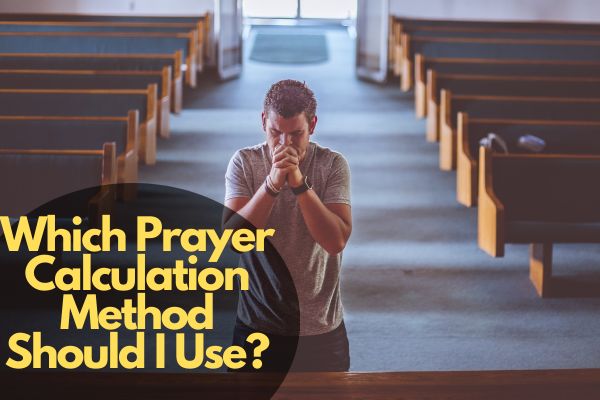Table of Contents Show
The call to prayer, a sacred and integral part of many cultures, demands precision and accuracy. Choosing the right prayer calculation method is essential for devout individuals seeking to align their worship with the divine timings. Let’s embark on this journey of exploration.
Which Prayer Calculation Method Should I Use?
In a world where technology intertwines with tradition, the question of choosing a prayer calculation method becomes significant. As we navigate through different methodologies, the decision-making process can be perplexing. In this article, we’ll explore traditional and modern methods, compare their accuracy, and dig into factors influencing your choice.
Traditional Methods
Traditionally, many communities have relied on the sun’s position to determine prayer times. The sunrise and sunset hold cultural and historical significance, guiding believers in commencing and concluding their daily prayers. While these methods carry a sense of tradition, they may lack the precision sought in today’s fast-paced world.
Modern Methods
In the age of technology, astronomical calculations have gained popularity. Utilizing complex algorithms and celestial data, these methods promise a higher degree of accuracy. However, the question remains whether they align with the spiritual essence embedded in the prayer ritual.
Accuracy and Consistency
Comparing traditional and modern methods, the debate often centers around accuracy and consistency. While astronomical calculations boast scientific precision, traditional methods are deeply rooted in cultural practices. The choice depends on personal preferences and the level of adherence to tradition.
Commonly Used Prayer Calculation Apps
In the age of smartphones, numerous apps have emerged to assist believers in calculating prayer times. Apps like “PrayOnTime” and “iSalah” use advanced algorithms to provide real-time and precise prayer timings, making them popular choices among the tech-savvy religious community.
Factors Influencing Prayer Times
Prayer timings are influenced by various factors, including geographical location, season, and daylight duration. Understanding these influences is crucial for selecting a calculation method that aligns with your surroundings and lifestyle.
Geographical Location
One must consider their geographical location when selecting a prayer calculation method. Different methods may be more suitable for specific regions, taking into account variations in daylight hours and seasonal changes.
Technological Advancements
The advent of technology has brought prayer calculations to our fingertips. Mobile apps and online platforms offer convenience but raise questions about the authenticity of the calculations. It’s crucial to strike a balance between technological advancements and religious authenticity.
Personal Preferences
Individual preferences play a crucial role. Some may prioritize flexibility and convenience, leaning towards modern methods, while others find solace in the traditions of their forefathers. The key is to find a method that aligns with personal beliefs and practices.
Community Preferences
Different communities may have preferences for specific calculation methods based on cultural or religious traditions. Some may prioritize traditional methods for their historical significance, while others embrace technological advancements for accuracy.
Cultural Influences
Cultural influences cannot be ignored. Different regions may have distinct prayer calculation practices deeply rooted in local customs. Understanding and respecting these cultural nuances contribute to a more meaningful prayer experience.
Controversies Surrounding Calculation Methods
Debates and controversies surround the choice of prayer calculation methods. Some argue that technological methods deviate from the essence of tradition, while others believe that accuracy should take precedence over conventional practices. It’s essential to be aware of these debates when making a personal choice.
Flexibility in Prayer Timings
While precision is crucial, it’s equally important to acknowledge the variations in individual schedules. Balancing the rigidity of precise timings with flexibility ensures that religious practices remain accessible and adaptable to the challenges of modern life.
Significance of Accurate Prayer Times
Accurate prayer times hold immense significance for devout individuals. Timely prayers enhance the spiritual connection and discipline of the practitioner. Precision in prayer times is not merely a matter of routine; it reflects a commitment to one’s faith.
Popular Methods
Exploring popular methods within the Islamic society provides valuable insights. Understanding how the broader community approaches prayer calculations can aid individuals in making an informed decision.
Guidance from Scholars
Seeking guidance from religious scholars is pivotal. Their insights and interpretations of religious texts can offer clarity and help navigate through the sea of information available on prayer calculation methods.
Challenges in Decision-Making
The abundance of information can be overwhelming. Conflicting data and varying opinions can make decision-making challenging. It’s crucial to sift through the information and prioritize sources that align with religious teachings.
User Experiences
Personal experiences of individuals using different prayer calculation methods provide valuable insights. Testimonials can offer a glimpse into the practical aspects and challenges faced by individuals in their daily prayer routines.
Emerging Trends
As technology advances, so do prayer calculation methodologies. Exploring emerging trends provides a glimpse into the future possibilities of prayer calculations. Staying informed ensures individuals can adapt to evolving practices while staying true to their beliefs.
Commonly Used Prayer Calculation Apps
In the age of smartphones, numerous apps have emerged to assist believers in calculating prayer times. Apps like “PrayOnTime” and “iSalah” use advanced algorithms to provide real-time and precise prayer timings, making them popular choices among the tech-savvy religious community.
Adapting to Technological Changes
The integration of technology into religious practices is an ongoing process. Embracing the positive aspects of technological advancements can enhance the overall spiritual experience without compromising on faith.
Balancing Tradition and Innovation
Finding a balance between tradition and innovation is a personal journey. It involves introspection, understanding one’s beliefs, and choosing a method that aligns with both tradition and the practicalities of modern life
Conclusion
In conclusion, the choice of a prayer calculation method is deeply personal. It involves a delicate balance between tradition, technology, and individual preferences. By considering factors such as geographical location, cultural influences, and personal beliefs, individuals can make an informed decision that enhances their spiritual journey.
FAQs
Is there a universal prayer calculation method?
No, prayer calculation methods vary, and there isn’t a universal approach. It often depends on individual beliefs, cultural influences, and geographical locations.
Can I use a combination of traditional and modern methods?
Yes, many individuals choose to blend traditional and modern methods based on their preferences and spiritual inclinations.
How do technological advancements impact prayer calculations?
Technology has made prayer calculations more accessible but raises questions about authenticity. It’s essential to balance convenience with religious authenticity.






